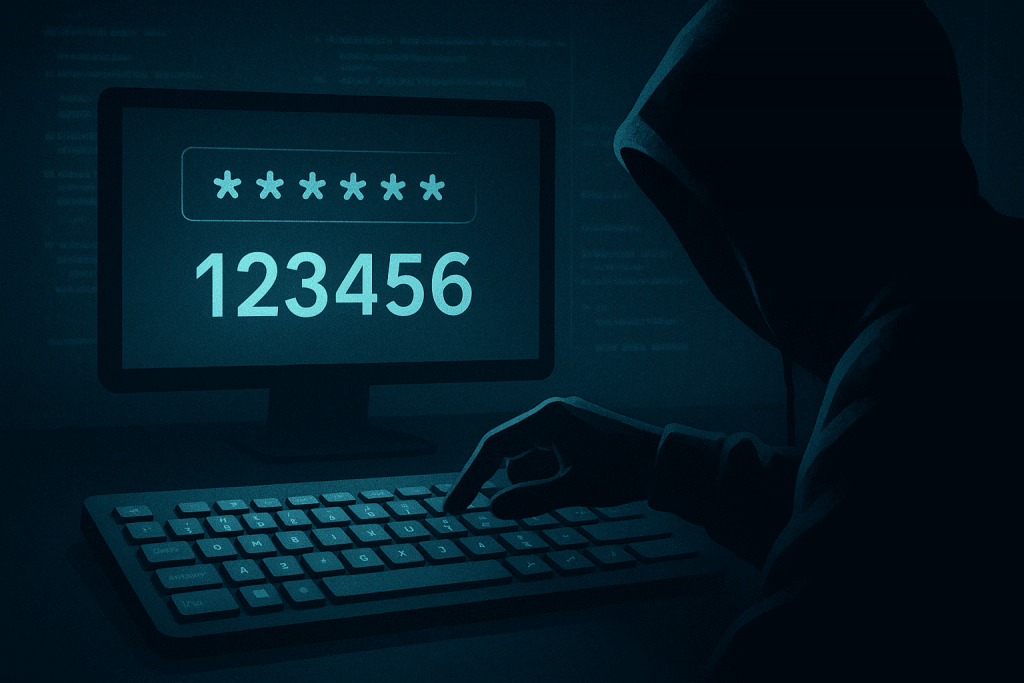
When we register on social networks, email services, or online banking websites, account protection often comes down to just a password. However, most users still rely on simple combinations that attackers can crack within seconds. Ukrainian cybersecurity experts repeatedly note that in mass password leaks, the same primitive keys appear again and again — such as “123456,” “qwerty,” or “password.” Most of these passwords are guessed by automated hacking tools in less than a second. To reduce risks, it’s important to know which combinations to avoid, how to create strong unique access keys, and why it’s safer to enter data only on websites with encrypted connections.
The Most Popular (and Worst) Passwords in the World and in Ukraine
An analysis of leaked passwords shows that the same common combinations are repeated year after year. People keep using digit sequences or words that are easy to guess. Here’s the global top 10 list of the weakest passwords:
- 123456
- password
- 123456789
- 12345678
- qwerty
- 111111
- 1234567
- 12345
- 123123
- admin
These combinations are common in many countries, and a brute-force tool would need less than a second to crack them. The Ukrainian top 10 almost mirrors the global one:
- 123456
- 123456789
- qwerty123
- qwerty
- 12345678
- 111111
- 1234567890
- qwerty1
- 1234567
- 123123
Other research clarifies that in 2024 the most popular passwords in Ukraine remain 123456 (used 4,981 times), 123456789 (2,626), and qwerty123 (1,998). Latin keyboard sequences (qwerty, qwerty1) and digit patterns (1234567, 123123) also remain on the list.
If you recognize your password in these lists — change it immediately, as it’s the first target for automated cracking programs.
Why Simple Passwords Are Dangerous
Using combinations like 123456 or qwerty means your account will appear at the top of a hacker’s dictionary. Even slightly longer passwords like 123456789 are just as weak, since they’re only extensions of the same sequence. Most popular passwords consist of consecutive numbers or letters on the keyboard, or familiar words (secret, password). These are always the first to be checked by attackers.
Online platforms frequently suffer data breaches, after which password lists become public. Hackers then use them for attacks on other accounts, so reusing the same password across different sites is very risky. Studies show that the top 10 personal and corporate passwords are nearly identical, highlighting how often people use weak combinations for both work and personal accounts. This means that a breach of one service often unlocks access to many others.
How to Create a Strong Password
Ukrainian cyber police remind us that passwords are the first line of defense between you and criminals. To make them effective, follow these simple rules:
- Length and complexity. A secure password should be at least 12 characters long and include uppercase and lowercase letters, numbers, and special symbols. Experts recommend extending it to 20+ characters. The longer the password, the harder it is to crack even with powerful computing.
- Avoid words and obvious patterns. Don’t use simple words, phrases, names, dates of birth, or repeated characters. Replace qwerty123 with a random string like h-S23/f2^rKA!. Such a combination is far stronger.
- Unique password for every service. If one of your accounts is compromised, the others remain safe. Never reuse the same password for banking apps, social networks, and email.
- Two-factor authentication (2FA). This extra layer of protection requires login confirmation via SMS, an app, or a hardware token. Even if your password is stolen, attackers can’t access your account without the second code.
- Password managers and generators. Writing passwords on paper is unsafe; instead, use password managers that generate, store, and sync strong combinations across devices. You can generate a unique password for each service using a trusted generator, such as one provided by cyber police or other reliable online tools. This removes the need to come up with new passwords manually.
- Regular checks and updates. Periodically check whether your passwords are strong and whether they’ve appeared in known leaks. Various services can show if your password has been compromised.
These simple steps will make hackers’ jobs much harder. Remember, even one strong password is harder to crack than a thousand short ones.
Secure Connections: Why SSL Certificates Matter
When visiting a website, look for the padlock in the address bar and check that the URL begins with https://. This indicates an encrypted channel between your browser and the server — meaning your passwords, payment details, and personal information are transmitted in a form unreadable to outsiders. If your browser warns “Not secure” or there’s no padlock, the information may be vulnerable, and it’s safer not to enter sensitive data.
SSL (more precisely, TLS) also ensures that you’re communicating with the website it claims to be: a digital certificate confirms authenticity and reduces the risk of page spoofing. For regular users, this is about trust: secure pages look more reliable and are safer for payments and logins.
Conclusion
Cybersecurity starts with the basics: strong passwords and secure connections. In the lists of most common passwords, 123456 and qwerty123 still lead. These combinations are cracked instantly, and reusing the same password across services exposes your entire digital life. To avoid becoming a victim, choose long and complex passwords, use generators, enable two-factor authentication, and keep your keys in password managers. And don’t forget the technical side: trust your data only to websites with SSL certificates and host your resources on reliable servers that provide encryption and backups. This is the only way to build a truly safe digital environment.

Leave a Reply